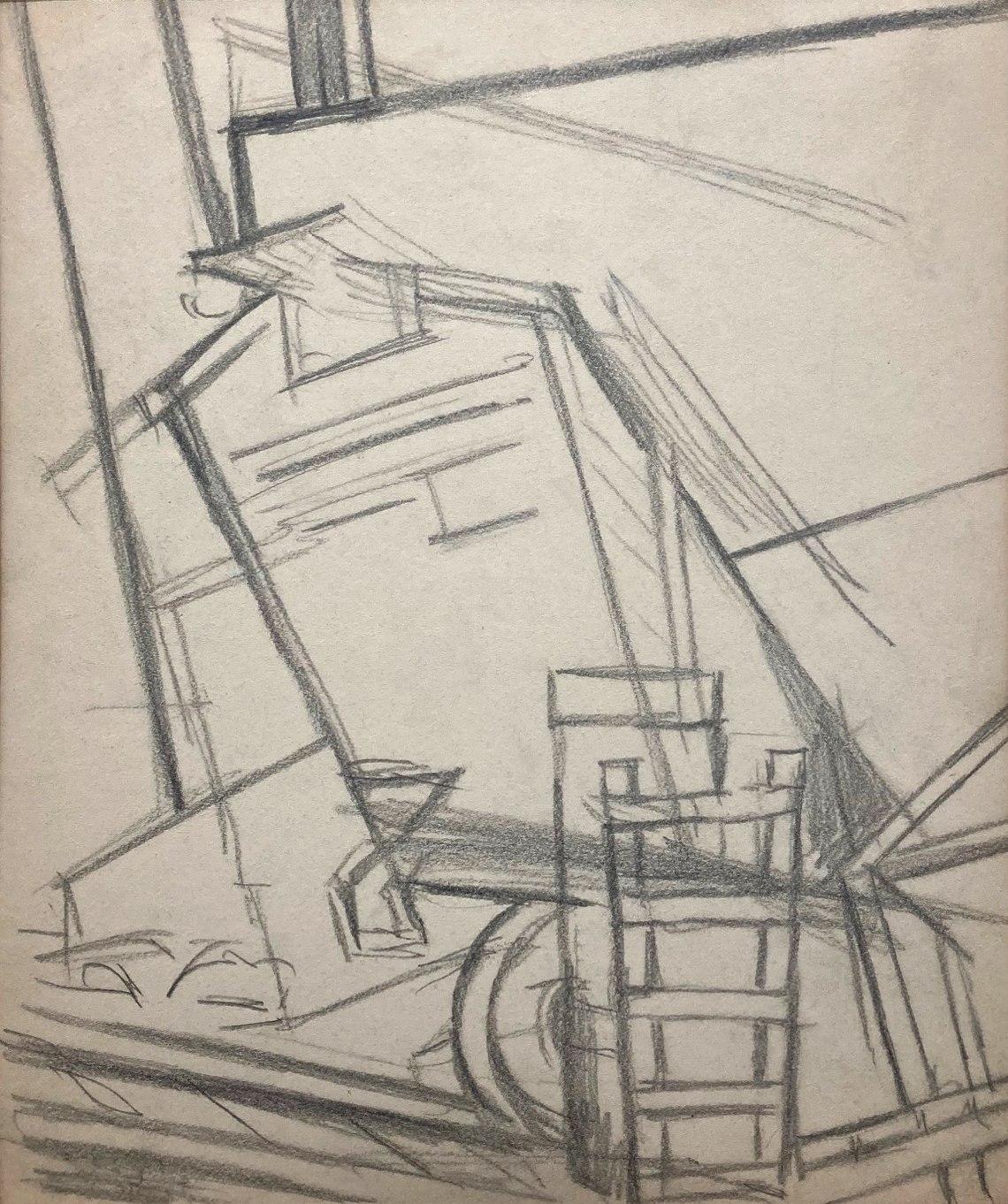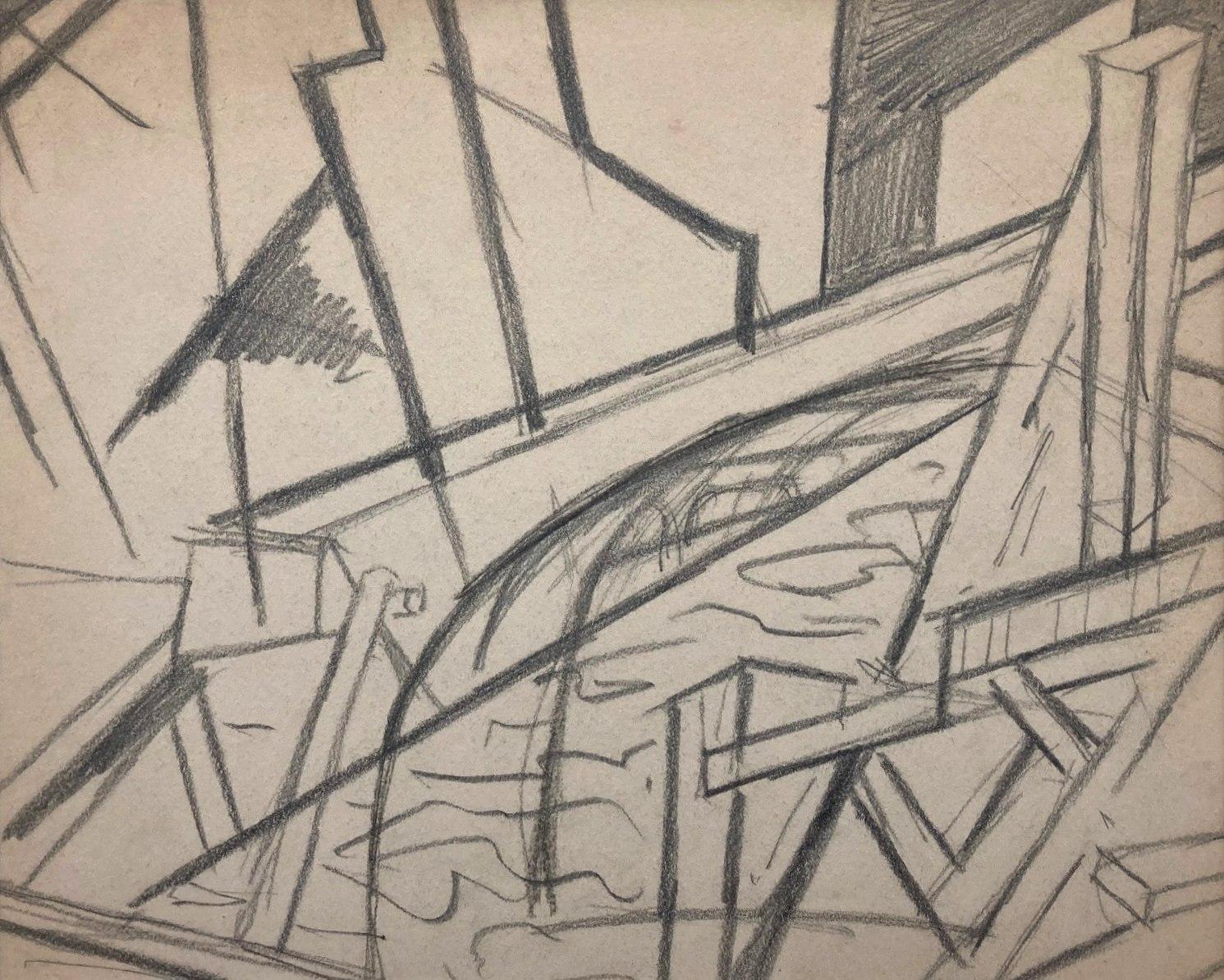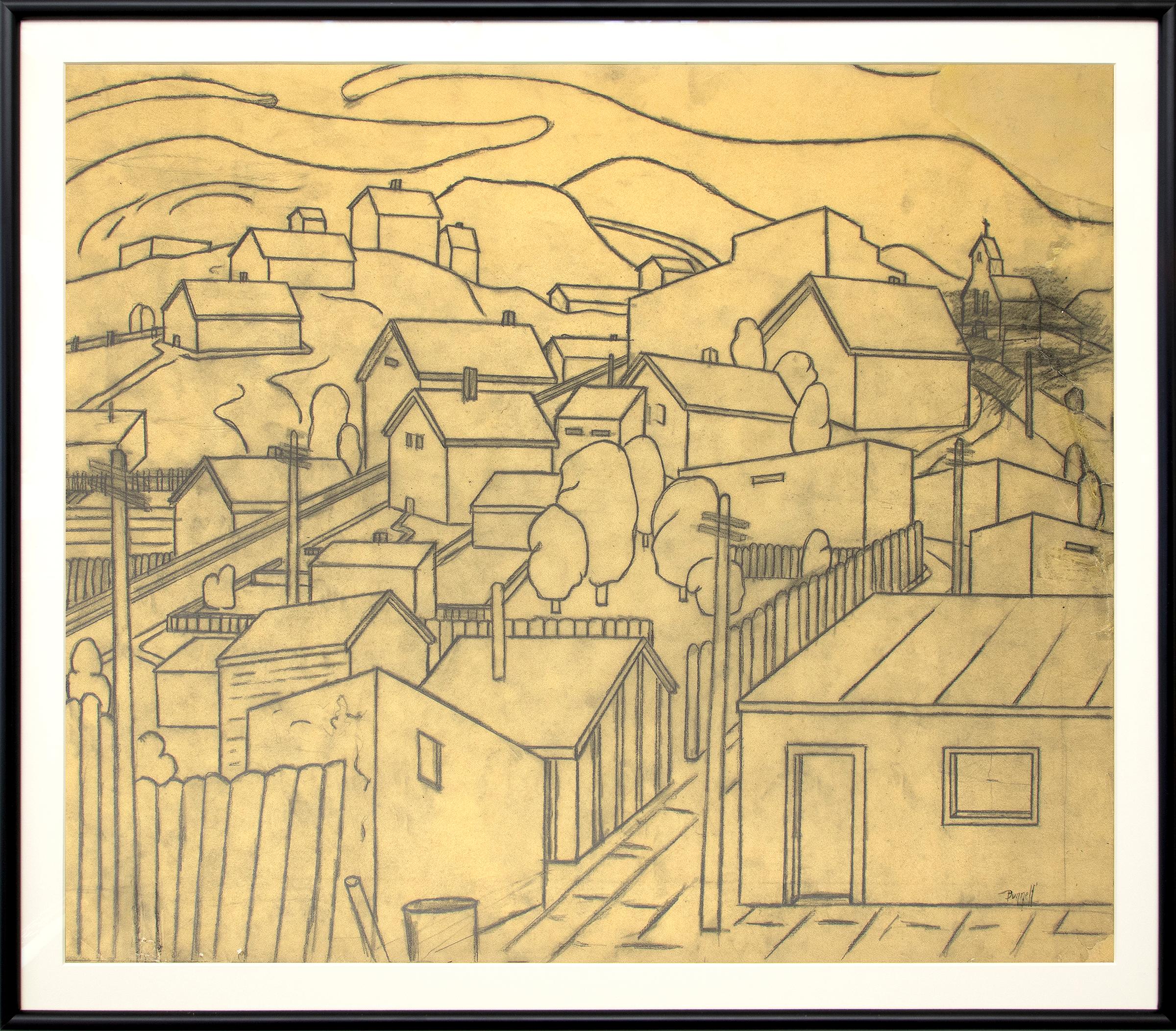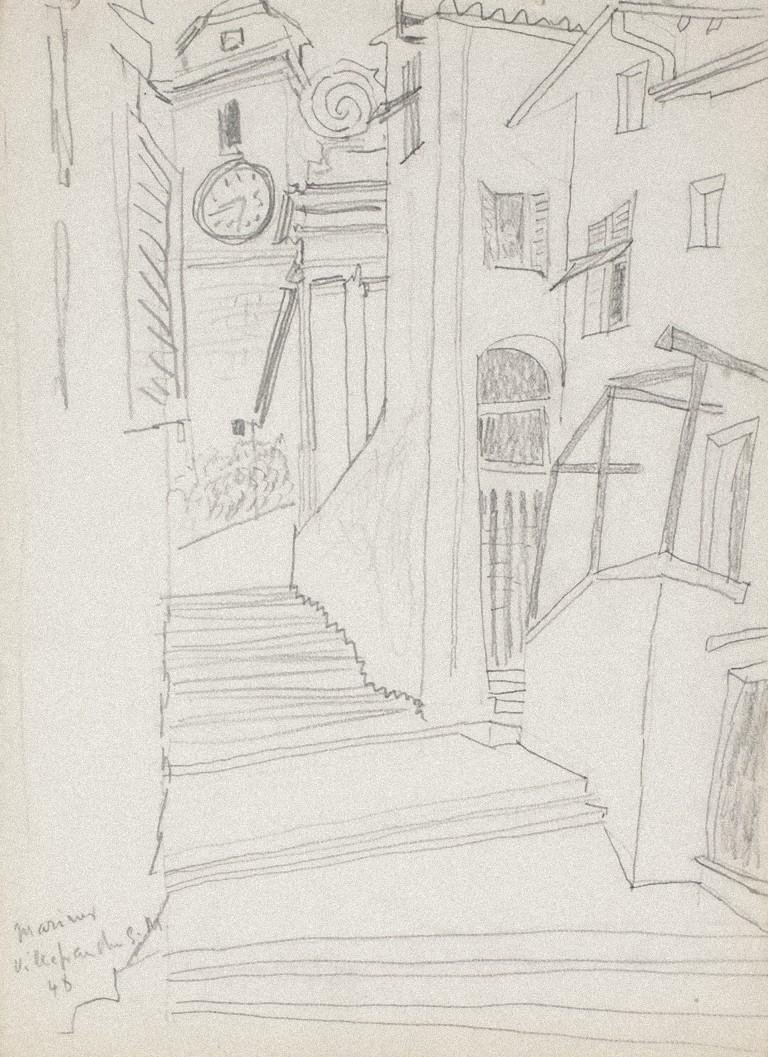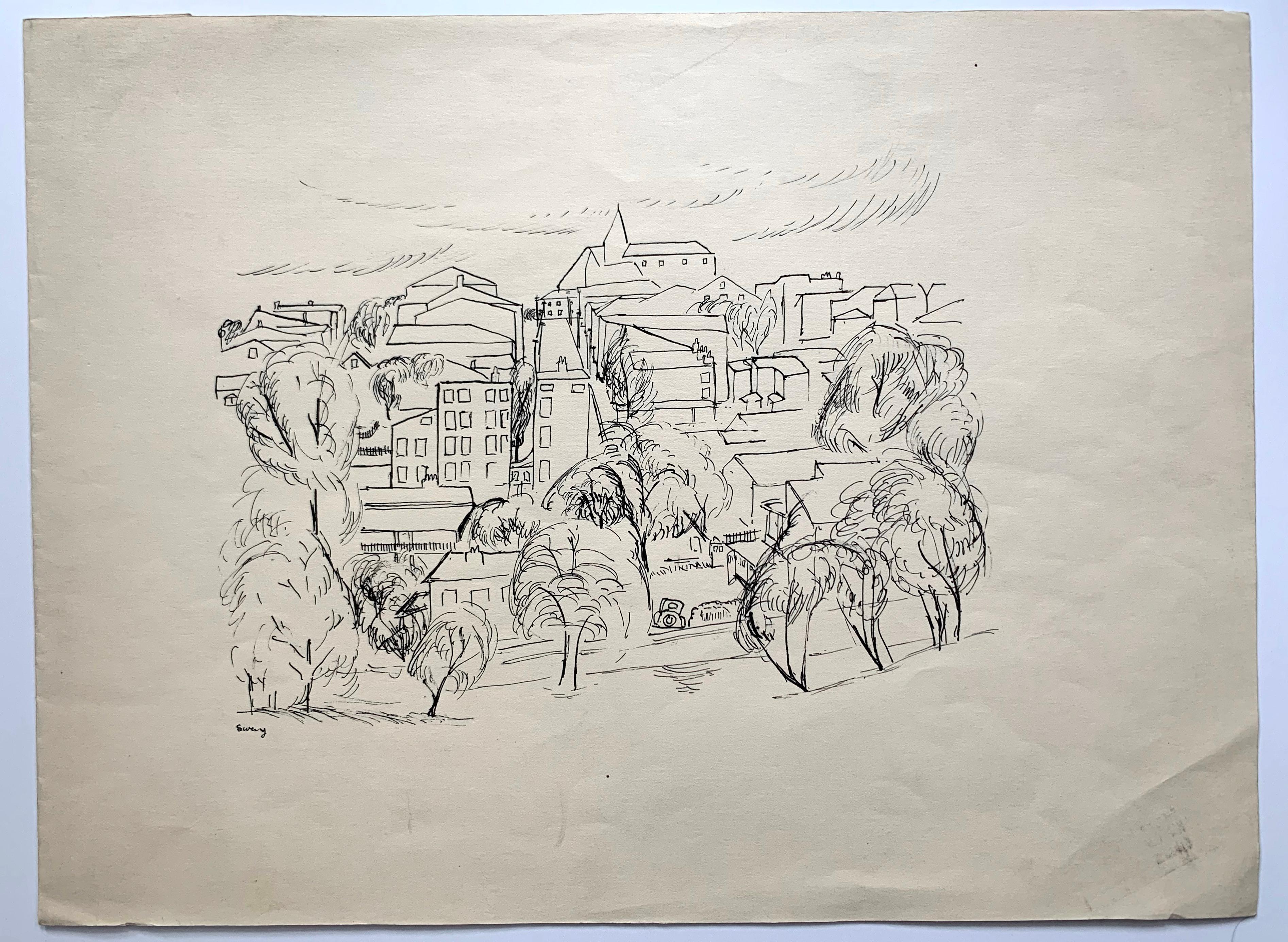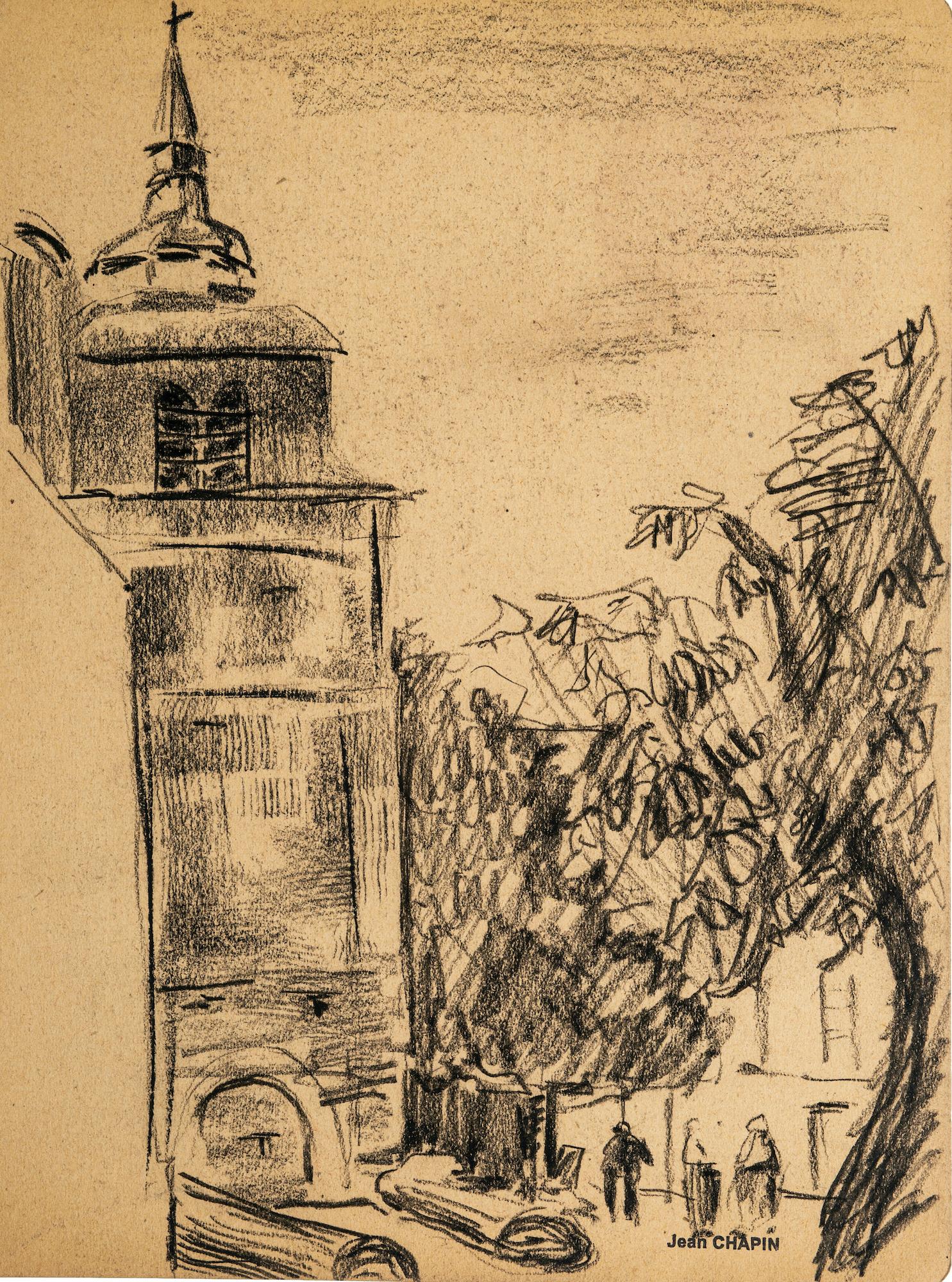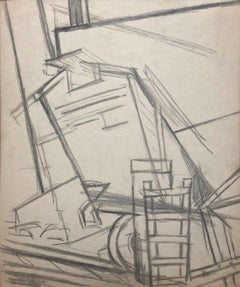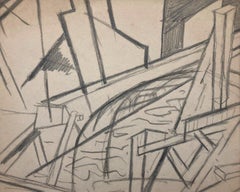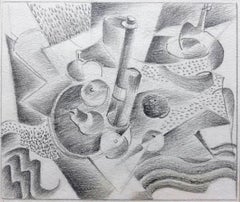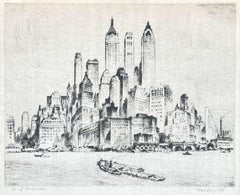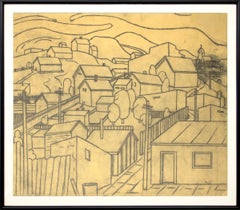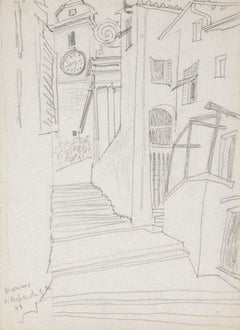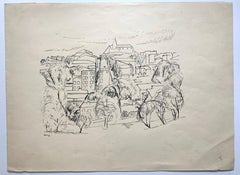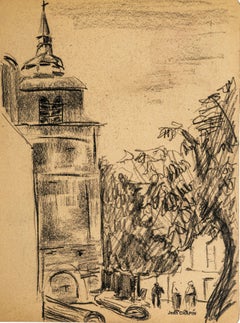Items Similar to A ca. 1940s Graphite on Paper Mural Study of a City Scene by Rudolph Weisenborn
Want more images or videos?
Request additional images or videos from the seller
1 of 8
Rudolph WeisenbornA ca. 1940s Graphite on Paper Mural Study of a City Scene by Rudolph Weisenborn
$500
£376.11
€433.52
CA$704.31
A$772.79
CHF 404.44
MX$9,510.44
NOK 5,095.37
SEK 4,772.57
DKK 3,237.08
About the Item
A ca. 1940s graphite on paper mural study of a Chicago city scene by notable Modern artist Rudolph Weisenborn. Artwork size: 12 1/2" x 9 1/4". Archivally matted to 18" x 16". Provenance: Estate of the artist.
Rudolph Weisenborn was born in Strassburg, Germany in 1881, but was orphaned at the age of nine. He was taken-in by Mid-Western farmer Thomas Westaby and spent his early years in Wisconsin, Iowa and North Dakota. Weisenborn first attended the University of North Dakota in 1898, then the Students School of Art in Denver. Various accounts have him working out west as a gold miner and cowboy.
Around 1912, he settled in Chicago and worked as a window designer for Marshall Field’s. Weisenborn is best known as the founder of the Chicago No-Jury Society of Artists. The group was founded because many artists could not get their work accepted into the mainstream Art Institute shows. Weisenborn is quoted as saying that he harbored feelings of disdain for any jury and that his own paintings were frequently rejected by conservative jurors. He was also involved and helped found other radical artist’s groups such as the Salon des Refuses, Cor Ardens and Neo-Arlimusic. In 1936, he helped found the New York-based American Abstract Artist’s Group. He created the only abstract mural for the 1933 Century of Progress Exhibition in Chicago and also worked for the Federal Arts Project in the Easel Division. His WPA murals can be found in Crane Technical High School and Nettlehorst Elementary School in Chicago, IL. In 1945, Chicago businessman Herman Spertus commissioned Weisenborn to paint the mural “The Fighting Navy” for the Great Lakes Naval Training Station. He taught at Hull House (1920), the Chicago Academy of Fine Arts (1922-34), his own Weisenborn Art School (1934-64), and the Austin, Oak Park, River Forest Art League in Oak Park (1941). Weisenborn died in Chicago in 1974.
- Creator:Rudolph Weisenborn (1881-1974, American)
- Dimensions:Height: 18 in (45.72 cm)Width: 14 in (35.56 cm)
- More Editions & Sizes:Archivally matted to: 18" x 16"Price: $500
- Medium:
- Movement & Style:
- Period:
- Condition:See photos.
- Gallery Location:Chicago, IL
- Reference Number:Seller: #52761stDibs: LU2591216003372
About the Seller
5.0
Recognized Seller
These prestigious sellers are industry leaders and represent the highest echelon for item quality and design.
Established in 2000
1stDibs seller since 2023
87 sales on 1stDibs
Typical response time: <1 hour
- ShippingRetrieving quote...Shipping from: Chicago, IL
- Return Policy
Authenticity Guarantee
In the unlikely event there’s an issue with an item’s authenticity, contact us within 1 year for a full refund. DetailsMoney-Back Guarantee
If your item is not as described, is damaged in transit, or does not arrive, contact us within 7 days for a full refund. Details24-Hour Cancellation
You have a 24-hour grace period in which to reconsider your purchase, with no questions asked.Vetted Professional Sellers
Our world-class sellers must adhere to strict standards for service and quality, maintaining the integrity of our listings.Price-Match Guarantee
If you find that a seller listed the same item for a lower price elsewhere, we’ll match it.Trusted Global Delivery
Our best-in-class carrier network provides specialized shipping options worldwide, including custom delivery.More From This Seller
View AllA Graphite on Paper Mural Study of a Rail Yard by Rudolph Weisenborn, ca. 1940
By Rudolph Weisenborn
Located in Chicago, IL
A graphite on paper, untitled mural study, Cubist scene of a rail yard by important Chicago Modernist artist Rudolph Weisenborn, ca. 1940. Artwork size: 11 3/4" x 9 3/4". Archivally matted to 16" x 18". Provenance: Estate of the artist.
Rudolph Weisenborn was born in Strassburg, Germany in 1881, but was orphaned at the age of nine. He was taken-in by Mid-Western farmer Thomas Westaby and spent his early years in Wisconsin, Iowa and North Dakota. Weisenborn first attended the University of North Dakota in 1898, then the Students School of Art in Denver. Various accounts have him working out west as a gold miner and cowboy.
Around 1912, he settled in Chicago and worked as a window designer for Marshall Field’s. Weisenborn is best known as the founder of the Chicago No-Jury Society of Artists. The group was founded because many artists could not get their work accepted into the mainstream Art Institute shows. Weisenborn is quoted as saying that he harbored feelings of disdain for any jury and that his own paintings were frequently rejected by conservative jurors. He was also involved and helped found other radical artist’s groups such as the Salon des Refuses, Cor Ardens and Neo-Arlimusic. In 1936, he helped found the New York-based American Abstract Artist’s Group. He created the only abstract mural for the 1933 Century of Progress Exhibition in Chicago and also worked for the Federal Arts Project in the Easel Division. His WPA murals can be found in Crane Technical High School and Nettlehorst Elementary School in Chicago, IL. In 1945, Chicago businessman Herman Spertus...
Category
1940s Cubist Abstract Drawings and Watercolors
Materials
Paper, Graphite
A Cubist, Untitled Mural Study of a City Scene by Artist Rudolph Weisenborn
By Rudolph Weisenborn
Located in Chicago, IL
A graphite on paper, untitled mural study, Cubist city scene by important Chicago Modernist artist Rudolph Weisenborn, ca. 1940. Artwork size: 9 3/4" x 11 3/4". Archivally matted to 16" x 18". Provenance: Estate of the artist.
Rudolph Weisenborn was born in Strassburg, Germany in 1881, but was orphaned at the age of nine. He was taken-in by Mid-Western farmer Thomas Westaby and spent his early years in Wisconsin, Iowa and North Dakota. Weisenborn first attended the University of North Dakota in 1898, then the Students School of Art in Denver. Various accounts have him working out west as a gold miner and cowboy.
Around 1912, he settled in Chicago and worked as a window designer for Marshall Field’s. Weisenborn is best known as the founder of the Chicago No-Jury Society of Artists. The group was founded because many artists could not get their work accepted into the mainstream Art Institute shows. Weisenborn is quoted as saying that he harbored feelings of disdain for any jury and that his own paintings were frequently rejected by conservative jurors. He was also involved and helped found other radical artist’s groups such as the Salon des Refuses, Cor Ardens and Neo-Arlimusic. In 1936, he helped found the New York-based American Abstract Artist’s Group. He created the only abstract mural for the 1933 Century of Progress Exhibition in Chicago and also worked for the Federal Arts Project in the Easel Division. His WPA murals can be found in Crane Technical High School and Nettlehorst Elementary School in Chicago, IL. In 1945, Chicago businessman Herman Spertus...
Category
1940s Cubist Abstract Drawings and Watercolors
Materials
Paper, Graphite
Ca. 1945 Cubist Graphite on Paper Still Life Drawing by Artist Stanley Bielecky
By Stanley Bielecky
Located in Chicago, IL
A ca. 1945, Cubist black & white graphite drawing of fruit by artist Illinois and Michigan artist Stanley Bielecky. Image size: 4" x 5". Archivally matted to: 13 1/4" x 16".
Stanley Bielecky was an Indiana artist who painted the American scene, from the factories and workers around East Chicago to the bucolic settings of Mackinac Island...
Category
1940s American Modern Drawings and Watercolor Paintings
Materials
Graphite, Paper
A ca. 1940 Etching Titled "Tip of Manhattan" by Artist Nat Lowell
By Nat Lowell
Located in Chicago, IL
A ca. 1940 etching of a view of the Manhattan skyline by artist Nat Lowell. Signed and titled in pencil, ca. 1940. Artworks size: 4 1/4" x 5 1/4". Arc...
Category
1940s American Modern Landscape Prints
Materials
Etching, Paper
A ca. 1938 Graphite on Paper Study of Classical Drapery by Modernist Jan Matulka
By Jan Matulka
Located in Chicago, IL
A ca. 1938 graphite on paper, study of a classical drapery by notable Modernist artist Jan Matulka. The image is drawn on the back of a typewritten, folded sheet of stationery, from...
Category
1930s American Modern Still-life Drawings and Watercolors
Materials
Paper, Graphite
A Large, 1950s Mid-Century Modern Ink Drawing of Quebec City by Rudolph Pen
Located in Chicago, IL
A Large, 1950s Mid-Century Modern Ink Drawing of Quebec City by Rudolph Pen. Artwork is formatted in a trapezoid shape, an innovative composition device for which the artist's work ...
Category
Mid-20th Century American Modern Landscape Drawings and Watercolors
Materials
Paper, Ink
You May Also Like
Charles Ragland Bunnell 1935 Graphite Drawing, Colorado Modernist Cityscape
By Charles Ragland Bunnell
Located in Denver, CO
This circa 1935 graphite on paper drawing by Charles Ragland Bunnell (1897–1968) depicts a modernist cityscape of houses perched on a hill in Colorado, reflecting the vibrancy and in...
Category
1930s American Modern Landscape Drawings and Watercolors
Materials
Graphite
Landscape - Pencil on Paper - 1948
Located in Roma, IT
Landscape is a drawing in pencil on paper realized in 1948 by an anonymous artist of the 20th Century.
Hand-signed barely illegible, on the lower lef...
Category
1940s Figurative Drawings and Watercolors
Materials
Pencil
Cincinnati Ohio cityscape drawing WPA era
Located in Wilton Manors, FL
Beautiful original drawing by American artist, Albert Sway (b.1913). Cincinnati Cityscape, ca. 1935. Ink on paper measures, image measures 7 x 9.5 inches on a sheet measuring 11 x 15...
Category
1930s American Realist Landscape Drawings and Watercolors
Materials
Paper, Ink
Cityscape - Charcoal Drawing by Jean Chapin - Early 1900
By Jean Chapin
Located in Roma, IT
Cityscape is a charcoal drawing realized by Jean Chapin in the XX century.
Signature stamp of the artist on the lower right margin. The drawing is detached from a notebook.
The ar...
Category
1920s Figurative Drawings and Watercolors
Materials
Charcoal
Cityscape - Original Charcoal Drawingr by S. Goldberg - Mid 20th Century
By Simon Goldberg
Located in Roma, IT
City is an original drawing in pencil realized by Simon Goldberg (1913-1985). Hand-signed on the lower right.
The state of preservation is good.
Sheet dimension: 27 x 21 cm.
The a...
Category
Mid-20th Century Contemporary Landscape Drawings and Watercolors
Materials
Charcoal
Cincinnati Ohio cityscape drawing WPA era
Located in Wilton Manors, FL
Beautiful original drawing by American artist, Albert Sway (b.1913). Cincinnati Cityscape, ca. 1935. Ink on paper measures, sheet measures 11 x 17 inches. Signed lower right. No da...
Category
1930s American Realist Landscape Drawings and Watercolors
Materials
Paper, Ink
More Ways To Browse
1940 Paintings Of New York City
Mid Century Murals
Naval Academy
Gold Miner
Wpa Mural
Naval Academy Vintage
Marshall Fields Vintage
American Painting 1940s
Herman Spertus
Lavere Hutchings
Maryann Stow On Sale
Max Ludby
Orlando Norie
Pugin Stained Glass
Richard Leitch
Robert Sugita
Robert T Hayes
Robert William Arthur Rouse
